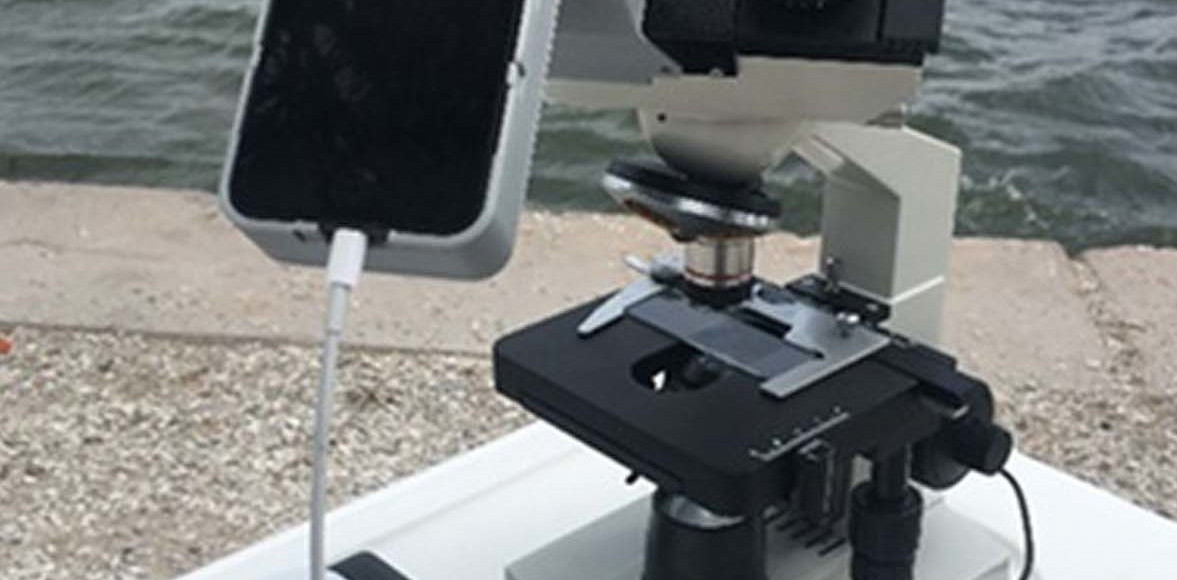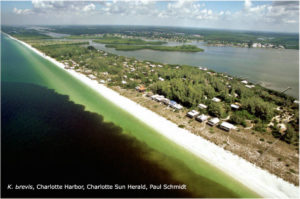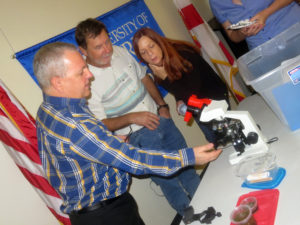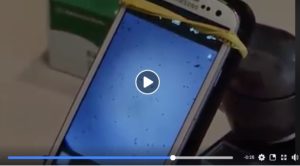
A new study published in the peer-review journal PLoS ONE shows that citizen  science volunteers using a relatively low-cost tool can help increase the size and accuracy of a red tide monitoring network to better protect public health from the impacts of toxic algae in the Gulf of Mexico.
science volunteers using a relatively low-cost tool can help increase the size and accuracy of a red tide monitoring network to better protect public health from the impacts of toxic algae in the Gulf of Mexico.
The study — “HABscope: A tool for use by citizen scientists to facilitate early warning of respiratory irritation caused by toxic blooms of Karenia brevis” — shows that it’s possible to:
- Increase red tide monitoring over a wider geographic area;
- Provide more accurate scientific data about red tide concentrations based on water samples instead of anecdotal reports from beach observers;
- Expand the red tide monitoring network throughout the Gulf states in a cost-effective fashion.
The Cost of Red Tides
While most species of algae are harmless to humans and animals, some — like the Karenia brevis organism that causes red tides in the Gulf of Mexico — are toxic. When these species multiply, creating harmful algal blooms (HABs), they can wreak havoc on human and marine animal health, contaminate seafood and devastate local economies.
Red tides are especially harmful to asthmatics and people with other chronic respiratory diseases, and these groups are more likely to need emergency medical attention during blooms. One Sarasota-based study estimated that the cost for these increased ER visits ranged from $500,000 to $4 million, depending on a bloom’s severity and duration.
Scientists and health experts have developed tools designed to better protect the public from the health impacts of toxic blooms, including triggers for the closure of shellfish beds, weather forecasts that predict red tide impacts on coastal communities, a reporting system that alerts the public when red tide is impacting beaches and, most recently a red tide respiratory forecast being tested in Pinellas County.
Now, scientists have created a new tool, dubbed “HABscope” that can provide more accurate scientific data on bloom concentrations — with the goal of providing information about “every beach, every day” — that also will help improve forecast models that predict a toxic bloom’s movement patterns.
“We want to improve red tide forecasting from an 18-to-30-mile coverage area down to the beach level,” said Dr. Barbara Kirkpatrick, Executive Director of the Gulf of Mexico Coastal Ocean Observing System. “The accessibility of HABscope — both from a financial standpoint and from an ease-of-use standpoint — brings us closer to that goal.”
Kirkpatrick helped lead the development of the first system to alert the public to red tide impacts on beaches — the Beach Conditions Reporting System — in 2006, following a 10-year, CDC-funded study that documented the health effects of red tide on humans. That system is still operational and maintained by Mote Marine Laboratory, based in Sarasota, Fla. It covers 29 beaches on Florida’s Gulf coast, seven beaches in Florida’s Panhandle and one beach on Florida’s east coast.
“Back then, we created a network of lifeguards and other beach workers who were trained to recognize impacts of red tide on their beaches,” Kirkpatrick said. “They then uploaded their observations via Blackberries — and then smart phones — to our data clearing house which then provided it to the public via the Internet.
“At the time we created the system, that was the best way to utilize the technologies of the day. Today, we have so many other options and new technologies that we can gather better data, over a larger area, at a cheaper cost. Of course, we still rely on a volunteer network, so the human factor remains key to making a forecast on every beach, every day possible.”
How HABscope Works
To develop HABscope, researchers took a low cost, classroom-grade, portable microscope, outfitted it with a special adaptor — designed by the team’s engineer and printed on a 3D printer — then used that piece to mount an Apple iPOD touch to the eyepiece of the microscope. A portable power pack provides the power to light the microscope.
portable microscope, outfitted it with a special adaptor — designed by the team’s engineer and printed on a 3D printer — then used that piece to mount an Apple iPOD touch to the eyepiece of the microscope. A portable power pack provides the power to light the microscope.
Then, a citizen science volunteer collects a water sample, places it under the microscope and uses the iPOD touch to take a video. And that’s where deep learning comes into play.
GCOOS Research Specialist and Product Developer Robert Currier used open-source machine-learning software (TensorFlow) to build a model that would help the computer automatically identify Karenia brevis cells in the water sample as well as the number of cells present — the concentration of cells. The automated process also reports its findings to researchers making red tide forecast models and can be shared with the public, for more accurate reports about whether red tide is on a local beach and whether the concentrations are high enough to warrant a public health concern.
In all, it took some 58,819 images of K. brevis cells to develop the model and “teach” the computer to recognize red tide, Currier said.
“Determining cell concentrations previously required a water sample to be transported to a lab where a trained technician would review a slide to determine whether it contained K. brevis cells and counted each individual cell,” Currier said. “Now, we’ve demonstrated that we can automate the process with a high-degree of accuracy.”
And the tool is also cost-effective. Mobile phone-based microscope systems are available commercially or through custom order but costs range from $1,000 to $3,000.
The cost for HABscope? About $400.
“The difference in cost is a really important factor when you’re talking about creating a network of hundreds of people gathering water samples to see whether they contain red tide,” Kirkpatrick said. “Especially when we’re talking about public dollars to pay for it.”
Expanding the Forecast
“Our forecast abilities have come a long way since the early 2000s,” said Dr. Richard Stumpf, Oceanographer with the NOAA National Centers for Coastal Ocean Science who led the team developing HABscope with a three-year, $1.1 million grant from NASA. “When we initially created our forecast models, our goal was to help aquaculture officials know when to close shellfish harvesting areas to protect the public from neurotoxic shellfish poisoning, which is caused by eating seafood containing red tide toxins.
“But later research showed that the airborne toxins are not only a nuisance, but also a human health risk. So we knew we needed to protect the public from that risk as well. Today, our forecasts provide information about where red tides are and where they’re going on a county level. But red tide blooms are patchy and the effects can vary greatly from beach to beach — even when the beaches are right next door to each other. By bringing in new technology, this project will get us much closer to the goal of a forecast for every beach, every day.”
So far, citizen science volunteers have been trained or are being trained through volunteer networks developed by the Florida Fish and Wildlife Conservation Commission’s (FWC) Wildlife Research Institute, the Clearwater Aquarium, Mote Marine Laboratory, Collier County Pollution Control, New College of Florida, Sanibel Sea School, Sanibel Captiva Conservation Foundation and the Texas Red Tide Rangers.
Now that the team has determined that HABscope is an accurate, reliable, cost-effective tool, the next step is to get ’scopes into more hands, Kirkpatrick said.
“Our next steps are to continue to expand the number of volunteers who are trained to use HABscope effectively and correctly and to get more HABscopes into the field with them. Funding support from local, state and federal sources could go a long way to making that happen.”
Read the paper at PLoS ONE
Other Study Authors:
The study’s authors also included Drs. D. Ransom Hardison and R. Wayne Litaker with William C. Holland of the National Oceanic and Atmospheric Administration, National Ocean Service, Center for Coastal Fisheries and Habitat Research, Beaufort, North Carolina; Drs. Tracy Fanara and and Gary J. Kirkpatrick with Devin Burris, Mote Marine Laboratory and Aquarium, Sarasota, Florida, and Andrew Reich, Florida Department of Health.














